It's said that after the passing of the Great Bird Glynmarra, the myriad worlds her tattered wings created were very much out of balance. It's told in many tales that the bodies of the heavens were unruly and knocked about quite wild. Using the stars as stepping stones the magnificent and enormous insect Minotajo, said to be made of starstuff himself, set out after Glynmarra.
Finding a a rather stable star to begin with, Minotajo fixed a great strong and silvery thread to it and, folding back the gossamer of his four translucent wings, he repelled gracefully to a neighboring star and affixed his thread there. And so it was that Minotajo began to construct the great web, or net, that gave place to all the worlds and all their moons, suns and stars.
Early depictions of Minotajo, also known as Mino, Jajota and Tajotajo in various Miriconian cultures, show him with wings, perhaps because it was thought that he could only have traveled in this way through nothingness until there was something to set foot upon. Later images show him devoid of wings, as it is thought that at some point he entangled himself badly in a rambunctious cluster of stars and was able to tear free, but not without losing his wings. In compensation it is said that Oraphau the Moth gifted Minotajo with eyes 'coming and going' so that he could see where he had been to be wiser about where he was going.

The world, which once was N'Miridin, or whole, has split into two parts, and has become Iridia, the human realm, and Mirico, the natural world. N'Miridin is still possible, but it is up to humans to reconnect with Earth. The content of this site strives to represent the Lands of Mirico in the hopes of restoring wholeness, so that we are no longer Iridia or Mirico, but once again N'Miridin.
Mission Statement: From the Artist

Drawing from the questions she had always asked from the time of her childhood, such as 'why can't we all just get along?' or 'why do we hurt ourselves and each other?' or 'why can't we be better to the earth?', artist Jorie Jenkins realized early on that she wished to create a framework in which to ask these questions of herself and others. In her paintings and drawings, in the languages she began to develop, in her sculptures, photographs, songs and writings, she engaged intimately with such questions. She studied the interrelation of creature and environment in her own world, and thought of how these relationships would be incredibly different if each aspect of the environment could literally speak for itself. She considered the interlacing of humans and nature, and pondered the gradual psychological and physical separation of 'man' from his natural origins. She absorbed this relationship within accounts of the historical, the religious and the mythical, and became fascinated with the rituals and customs that gave reverence to and 'spoke' to animals as equals, as gods or guides. She focused on the demarcation lines where animal and man seemed to blur. Then she considered ways in which a fully realized (and yet kinder) world would deal with spiritual and religious differences - with ethical, personal and social struggles, and with even the simplest drives for survival. She considered how the environment was being cared for or obliterated in her own realm, and began to see where her characters might establish themselves within this struggle. Some of the darker things she discovered as her realms evolved surprised her, but she realized that she was taking the seeds of inspiration from the pain and suffering of her own world, and raising inquiry in a creative construct. As the project progressed, it became overwhelmingly clear that the world itself, The Land of Mirico, was an ambassador, a voice made up of many voices, which raised commentary on the many directions in which the real and human world was moving. Viewing her collective works as something inherently meant to be shared, and perceiving the projects she envisioned as her legacy, the artist realized she had to devote to the giving of these ideas and images to others. For within herself, she discovered that every aspect of the work inspired change and engendered discovery. She believed that when the project was ready, an ensemble of artisans, visionaries and performers would also delve into the world, and make it all the more real and accessible with their own gifts and perspectives. Even if the deeper philosophies and harder inquiries do not boldly reveal themselves in every piece the artist shares, the whisper of a gentler world threads itself through every part of her work, and means to spark reflection and dialogue on the kinder places it is possible to create within our own communities, within our own natural environments, and within our own minds and hearts.
Ashta'Ar the Bluebard

One of my earliest existing characters, Ashta'Ar is a member of the 'bearded' race of Feathabees, and of the most ancient in the Lands of Mirico. While Ashta'Ar usually wears a hat, I thought for the purpose of this image his balding head would further display his 'vintage'.
A Young Firinbradian Bluebard Feathabee, in Autumn

A Brief Introduction by the Artist
When I was first introduced to the realm called 'Mirico', I was completely unaware just how vast and encompassing it would become. More than five years ago, with the random and uneventful painting of a single character, I became connected to a place where those who speak for nature and its interests step forward in song, in poem, in myth and folklore, in language, historical reference, flora, fauna and much more. I discovered that 'Iridia', the human realm of awareness, had a counterpart called 'Mirico', which, among others, is the name of the natural world. There is a balance which has in the past been achieved, known as 'N'Miridin', but in most places on Earth N'Miridin has all but disappeared. This is because humans on a large scale have separated from nature. The images, stories and other eccentricities you'll see here on this blog stray through Iridia, Mirico and at times N'Miridin - Throughout you'll find common jargon, lyrics, back story, historical evidence of Miriconian and Iridian interaction, and other oddities as well.
Paintings of the Lands of Mirico and their cast of characters evolved into illustrated and interrelated stories, sculptures, dolls, screenplays, elaborate narrative adventures. In the process the characters and worlds I have 'created' have in turn shaped me, and after a long deep dive into it, I've resurfaced with the blog you see before you. It's extensive, yes, but in truth it's only the tip of the iceberg. Please immerse yourself, and feel welcome. For the ambassadors of the natural realm have invited you back to your true home - a place of harmony, compassion and interdependence.
Paintings of the Lands of Mirico and their cast of characters evolved into illustrated and interrelated stories, sculptures, dolls, screenplays, elaborate narrative adventures. In the process the characters and worlds I have 'created' have in turn shaped me, and after a long deep dive into it, I've resurfaced with the blog you see before you. It's extensive, yes, but in truth it's only the tip of the iceberg. Please immerse yourself, and feel welcome. For the ambassadors of the natural realm have invited you back to your true home - a place of harmony, compassion and interdependence.
Salt water Siltweed

The Siltweed Shoehorn is found in nearly all the salt water seas and oceans of Mirico. Their cousins, the sea horse and the sea dragons, are more commonly known to Iridians.
The Three Worlds
IRIDIA
'Iridia' is any place on earth that has been smothered by asphalt, thieved of its resources by unnatural means, or altered by steel, glass or concrete. It is anywhere that the sky chokes on fumes, where the soil suffers poisons, or where the waters heave with grime, chemicals and garbage. An 'Iridian' is any being who makes contribution to these degredations of the natural world, or is any being who becomes aware of the degredations of the natural world and does nothing.
MIRICO
'Mirico' is any place where the voices of the earth still speak, or where voices speak for them. It is where the waters teem with life, where the soils burst with nature's seeds. It is where the elements can only destroy by their own powers, and not by the powers given to them by Iridia. A 'Miriconian' is any one who reveres the powers of nature, and protects them in action, in word and in deed. A Miriconian is anyone who remembers that he comes from the earth, and that he depends upon it.
N'MIRIDIN
'N'Miridin' in its simplest and most most natural state, occurs when an unrelated but interrelated community of organisms achieves a non-harming and sustainable measure of harmony, and maintains an equal distribution of resources, work and recreation.
Ta'me Hunter of the Dillydell Marsh

These agile, secretive creatures are experts at hunting the elusive salt water bogmaw, a giant carnivorous plant. The Ta'me only take the plants large enough to pose a threat to themselves or their neighbors, and spare smaller bogmaw because of their highly beneficial biochemical properties in the marsh environment. ..
Bry'e the Amnamar

Shown here as a youngster, Bry'e holds the crest of Wyandolor in her hand, and contemplates the meaning of it. Told by her forefeathers that Wyandolor is an eternal enemy, Bry'e struggles with the idea within herself.
Sand Scorpion of the Ocycan

Friends of the T'Mirineh, the Sand Scorpions, also known as the Ra'awudul, are an ancient and non-venomous species.
A Glyph from the Amnamaran Region, after the Breaking of N'Miridin

Cave paintings such as these can be found in Mirico, representing a time when the Amnamar, feeling threatened by the influx of humans and their destructive tendencies, rose up in arms against them.
A tribal member of the T'Mirineh, Ocycan Desert

Wearing a sand veil and traditional desert clothing, the T'Mirineh also wear a series of prayers, usually hand-sewn, on their daily garments. The T'Mirineh also use a prayer blanket or 'rug' which has prayers embroidered at its edges. Since the rug has four edges, there are four 'stages' of prayers - Prayers for others, prayers for family, prayers for those unknown, prayers for those unborn, and personal prayers. Each 'edge' of the blanket also bears a mantra.
Pirns from the Lands of Mirico

Made of many natural and sustainable materials, these pirns, or lanterns, are all lit by bioluminescent insects called 'beables'.
Nuck the Twizlard

As friend to Myka, Nuck is about the size of a squirrel, with 'twizles' that raise or lower with his moods and physicality. He's rather irreverent but highly opinionated. The way to his heart is through his tummy, and he especially likes chocolate.
Tools and daily items of the Amnamaran People

These implements represent a good number of the items found in the Hututhari Amnamar, an Equatorial tribe
Slit gong of the Naku Islanders, Central Zun Sea

Carved from a single Bythepalm tree, these huge instruments serve as communication between the tropical islands of the Naku people.
The Ocycan Prism

Used by Devotees of the Fire Speech, this prism allows an individual to decipher what a fire is saying.
The male Tsma-sng-puh, Turtle Folk of the Dillydell Marsh

Standing nearly two meters tall at maturity, the Tsma people are excellent swimmers, gifted songwriters and expert hunters. They are gentle, thoughtful creatures who alliance themselves with humans who prove themselves worthy.
Blackbard in Watercolor

After building Blackbard to life size in sculpture, I decided it was time to revisit him in painting. The jacket was particularly fun to 'ruin' when I painted it, and I'm happy with how destroyed it looks, much like the real jacket that the 'real' Blackbard wears...
The Dharak

a shaman living in the Amnamarandhi, this imposing figure is rarely seen, but deeply wise.
Female Tsma-folk.

The markings on the Tsma people's shells vary in color based on their age and their diet.
The Giving of a Gift

These Feathabees dolls (made of Polymer clay and found fabrics) were an absolute joy to make. J'Maari, on the left, has gone through several transformations before arriving at this appearance, and Oraela, on the right, is wearing a wrap for chilly weather, which conceals her elaborate gown.

Horned Highland Polkin and Featha'wees'
The Polkin are a shaggy, benevolent group of four-legs who have over a long period in history befriended the Feathabees of Mirico. It is said that before the N'Miridin split into the two words (the human world of Iridia and the Miriconian world) the Polkin wandered freely in all the lands, and are distant cousins of the Iridian llama and camel.

Gourd Harp, Courtesy of Akibir Twerdandle, Chilkin Province
From the upcoming 'Myths and Folklore of the Feathabees' book, this illustration shows a Miriconian gourd harp (and cogfish string cleaner), which is unusual for its depiction of the Earth serpent (and ancient Universal deity) named Creatoli. That he is painted on the instrument might be a respectful nod to the 'maker' of the gourd, who in some form is the Earth serpent himself.

Pookla (and her beautiful gourd home) appeared in the Ann Arbor Art Fair 'Ulrich's Art Fair Window' on South University, as ambassador to the Feathabees who were making their Art Fair debut in 2009.

One of my most famous Feathabee characters (who now appears on banners and business cards galore), Brynn Feathabee is shown here in soft clay form, before I had brought him fully 'to life'. It made me giggle to see him this way again, and thought that fans of the character might like to see him in his unpainted form...

Jhobar, Co-Pilot of Zarkola's Flying Machine
Elegant, poised and fluent in fifteen languages, Zhobar is a devout Muslim, but has absorbed many of the ways of the Miriconian world throughout his wanderings in it. The Arabic writing shown in his turban reflects his devotion to honoring others, and the pin worn at his forehead is the Miriconian letter 'M', for Mohammed.
The hammered copper pendant Jhobar wears shows the rising sun and moons of Mirico (which is a halved image of the N'Miridin symbol, if you look closely).
The lower half of the pendant takes the meaning of 'burying the light'. When we close our minds or our hearts, we, in a sense, extinguish possibility. The lower half of the pendant warns the wearer against this.
The hammered copper pendant Jhobar wears shows the rising sun and moons of Mirico (which is a halved image of the N'Miridin symbol, if you look closely).
The lower half of the pendant takes the meaning of 'burying the light'. When we close our minds or our hearts, we, in a sense, extinguish possibility. The lower half of the pendant warns the wearer against this.

Mother and Daughter, Anryn and Aeshoel
Born in the Iridian country of Argentina, Anryn crossed over to Mirico as a child and never went back. On an excursion to the South she met Fineyel, the man who would become her husband. Her daughter Aeshoel was born in Copirnikha, and although Fineyel disappeared on a trade route somewhere to the North, both Aeshoel and Anryn believe they will one day be reunited with him.
The characters embroidered on Anryn's shoulder strap are the first and last letters of the Miriconian alphabet. When connected, these two symbols create the 'evermore' or 'eternal' symbol.
The characters embroidered on Anryn's shoulder strap are the first and last letters of the Miriconian alphabet. When connected, these two symbols create the 'evermore' or 'eternal' symbol.

Weyth of Tirinah
As a hired 'Ice Runner' or 'Slipper' working for the Southernmost city in all the world, Copirnikha, Weyth runs a sled team back and forth between the outposts of Tirinah and the Iceburgs of the South. Weyth is a weathered and gruff gentleman unafraid to show his allegiance to the Kinnarit people, who have inverted the rather sacred 'Glynmarran' symbol of bird deity to the 'mask of the watcher', symbol of the Kinnarit resistance. To have this symbol tattooed prominently on your body can lead to trouble, and Weyth has been imprisoned in the past for it.

One of the first characters I conceived of when the Feathabees first appeared, Zwindar has made numerous appearances in story, in sculpture and in paintings. But it wasn't until recently that Zwin confessed to me he had lost an eye. While he won't say how just yet, I thought I should represent this in a painting for him.
The lovely spiral buttons on his beautiful 'waterfall' sleeves are Sea Ears from Arkhalorko (also known as Australia).
The lovely spiral buttons on his beautiful 'waterfall' sleeves are Sea Ears from Arkhalorko (also known as Australia).


Ochelochka Concept II
Still in the conceptual phase for some of my major characters, I've worked out a few different designs for the elegant and gigantic Ochelochka, guardian of the Silken Citadel. This painting reflects my idea to make her look slightly like a Portuguese Man-of-War.
With this design, I thought I went a bit to large on the body and too little on the legs... A middle ground will be found...
With this design, I thought I went a bit to large on the body and too little on the legs... A middle ground will be found...

Petrel-Atal Father and Hatchlings
The Petrel-Atal of the Southern Hemisphere face a daunting predicament. Because the Copirnikhan lands are quickly melting, the inhabitants of this region are soon to evacuate, and the lands of the Petrel-Atal sit adjacent to these disappearing worlds. The Petrel-Atal fear that when there are no more bergs to float upon, their territories will be overrun with environmental refugees.

The Ou-Ti Mother and Child
Exploring the different cultures represented within the lands of Mirico, I became interested in the mother and child aspect of the world. In the case of the Ou-Ti, a tropical race of Feathabees overseeing the activities of an earthly oracle of sorts known as the Creocothe Stone, the mother shown is dressed in a gown only worn for high ceremony. The Ou-Ti are usually less elaborate in their choice of clothing, but like many of their brethren, decorate themselves with scavenged leaves and feathers.
The silk headscarves worn by both Ashput'he (the mother) and Entmund (the sleeping toddler) were imported to their region by Miriconian traders who said they acquired the material from a beautiful and enormous spider named Ochelochka.
The silk headscarves worn by both Ashput'he (the mother) and Entmund (the sleeping toddler) were imported to their region by Miriconian traders who said they acquired the material from a beautiful and enormous spider named Ochelochka.

Amnamaran Mother and Infant
As part of the 'mother and child' series, I thought even the warring clan of Amnamarans would show some degree of tenderness to their young, and in the process discovered that some Feathabee mothers have a bit of 'marsupial' in them, carrying their little ones in a comfortable chest pouch. When the pouch is not inhabited by hatchlings, it can also be used for gathering and decoration.
Bry'e of the Amnamarandhi

Bry'e, the appointed future warrior queen of the Amnamaran clan, wears a headdress which includes the Ye'ishu'un flower, which is poisonous to humans.
As a youngster, Bry'e saw her clan commit terrible atrocities against Iridians who had done them no harm, and in the end she rejects the ways of her people and abandons them, joining a band of Iridians attempting to make positive change in her world. When she leaves her people behind, the headdress (and its ominous symbolism) is one of the first things she casts off.
As a youngster, Bry'e saw her clan commit terrible atrocities against Iridians who had done them no harm, and in the end she rejects the ways of her people and abandons them, joining a band of Iridians attempting to make positive change in her world. When she leaves her people behind, the headdress (and its ominous symbolism) is one of the first things she casts off.
Amnamaran Male

Fighting Staff Form
This Amnamaran male (he does not wear a headdress as the females do) is practicing with a fighting staff, the traditional weapon used by his clan to defend the Amamarandhi (or Amnamaran territory).
One of the most reclusive cultures in the Lands of Mirico, the Amnamarans have long been enemies of Iridians, and of Iridian sympathizers.
One of the most reclusive cultures in the Lands of Mirico, the Amnamarans have long been enemies of Iridians, and of Iridian sympathizers.
'looking in all directions with many eyes'

The Shelkies
In the vast and constantly shifting Dillydell Marshes (which encompasses most of the Pacific Ocean region of which Iridians are familiar) there are mollusk islands which walk, and in the vicinity one might stumble upon a creature like this Shelky. With some characteristics of the human form, these reclusive, slow and intelligent beings are believed to have Iridian ancestry. A myth of long ago describes the first humans to arrive in the Dillydell, and tells of the giant abandoned mollusk shells the people sought out for shelter. Living in them long enough, the people began to change.
Able to completely retract into their shells much like a turtle, the Shelkies guard a very special and unique region of the Dillydell where a human character of some note has decided to seek solitude. Anyone attempting to seek out this character will most likely meet the Shelkies, who not only have eyes on their snail-like heads, but also on the tips of every finger...
Able to completely retract into their shells much like a turtle, the Shelkies guard a very special and unique region of the Dillydell where a human character of some note has decided to seek solitude. Anyone attempting to seek out this character will most likely meet the Shelkies, who not only have eyes on their snail-like heads, but also on the tips of every finger...

Akrulho, High Guard of the Copirnikhan
There has been trouble in Copirnikha for some time now, mostly because the iceburgs there have speedily been melting away, and because the inhabitants of the region have nowhere to go but into the water once their floating villages vanish.
A member of the Petrel-Atal clan in the nearby lands of Atalquin, and a former member of the Arahun (the Iridian resistance), Akrulho has for some time been appointed guardian of the Second Ark of Copirnikha (the First having been sabotaged and ruined). Overseeing the gathering and organization of all Iridian detritus in the surrounding regions, Akrulho sees to it that the location of the Second Ark is kept secret.
The symbol on his carapace armor is the N'Miridin, a symbol and word which are ancient in their origins but somewhat new as a concept in present times. N'Mirdin means 'world as one', and in its patterns and symmetries represents multiple references to personal growth, religious tolerance, the balance of earth and the presence (and worth) of others.
A member of the Petrel-Atal clan in the nearby lands of Atalquin, and a former member of the Arahun (the Iridian resistance), Akrulho has for some time been appointed guardian of the Second Ark of Copirnikha (the First having been sabotaged and ruined). Overseeing the gathering and organization of all Iridian detritus in the surrounding regions, Akrulho sees to it that the location of the Second Ark is kept secret.
The symbol on his carapace armor is the N'Miridin, a symbol and word which are ancient in their origins but somewhat new as a concept in present times. N'Mirdin means 'world as one', and in its patterns and symmetries represents multiple references to personal growth, religious tolerance, the balance of earth and the presence (and worth) of others.

The P'Quan Beetles
The 'cows' of the Miriconian landscape, these large and lumbering insects loudly suck nectar out of flowers with their long, bright green and swirling tongues. Their favorite food, the P'Quan flower, looks remarkably similar to the beetles - Over the eons the P'Quans have learned to mimic the look of the plants on which they feed, thus disappearing into the foliage by simply standing still. Nearly four meters high when pointing their hindquarters straight up, their size belies their docile nature.
With breeding grounds on the coast near what we Iridians know to be Morocco, the P'Quans make a yearly migration to the Southernmost tip of South America, known by Miriconians as the tip of the Anqu'san, or Tirinah. The arrival of the beetles is a sure sign of the changing seasons, and many cultures believe the creatures to have magical qualities.
With breeding grounds on the coast near what we Iridians know to be Morocco, the P'Quans make a yearly migration to the Southernmost tip of South America, known by Miriconians as the tip of the Anqu'san, or Tirinah. The arrival of the beetles is a sure sign of the changing seasons, and many cultures believe the creatures to have magical qualities.
The Great Moth Makes a Suggestion...

This character, who appeared nearly four years ago, had a name before his persona even evolved, and was more a 'prop' in a mythical storyline than anything else. Quickly, however, the Great Moth of Dashmanaug became an integral part of the tale of the divided worlds, Iridia and Mirico.
Dashmanaug (based very much on one of my most favorite of actors, Chow Yun Fat) speaks the unique and timeless language of light, so that his words 'sound' luminous. He himself has a glowing quality, and it is believed by some that he is ancestor to the Divine Originator known as Oraphau the moth, who was the creator of Suns.

Mandalucian Male and Hatchlings
As I continue to work on the Three-Act Feathabee screenplay, which is developing exponentially and taking me in directions I always dreamed I might go, I began to think about the ancestral 'link' between lizards and birds in the Iridian sense. As the Lands of Mirico are the world of Nature 'amplified', (and remembering that I have already hinted at an evolutionary link between Feathabees and their close cousins, the Lizabards) I realized I should establish characters that are a visible blend of these characteristics. The Mandalucians were always a lizard race, but as I began to sketch them and build into their biology a fusion of bird and reptilian traits, I discovered that the link I needed was there before me.
Also, I have put into the 'cauldron' of creation the inkling that humans came up with the idea of Dragons from more than just their imaginations. If at some point an ancient human culture interacted with creatures such as the one pictured above, they might bring back stories of giant lizards, who in some cases breathed smoke or even spouted fire.

As part of the ecosystems series, the Eu'kahru (also lovingly nicknamed the 'plantapus') is a creature commonly seen in the Lands of Mirico. In the shallows of coastal waters these animals will settle onto the sea bottom, their plantlike appendages streaming along in the current. Docile but highly secretive, they will flee when agitated. Like the octopi of Iridian lands, they do have an ink-spurting camouflage defense, but the Eu'Kahrun spout an unusual purple ink, which when tasted, resembles licorice.
This doll came together in a unique way, and is made of leaves, pulled silk and also has details made from a napkin from a Japanese restaurant (see her lapel and belt).
Having quite a collection of old paper money and other worldly ephemera, as I put the materials together for this doll my thoughts turned to one of my prize 'possessions', a book of original (and stunning!) poetry from 1820, which was penned by my great-great grandfather from Truro, England. I carefully scanned some of the pages from his book and then slightly altered the shading of the scans by darkening them to bring forth the very faded hand-lettering on each page. Printing out the scanned images onto high quality art paper, I produced a material beautifully suitable for the head, hands, feathers and feet of the doll. Thus, my ancestor and I have worked collaboratively to make this unusual, organic Feathabee.
PS - Though it is difficult to see in the photograph, the doll has flower petals for shoes and a real dragonfly brooch.
Having quite a collection of old paper money and other worldly ephemera, as I put the materials together for this doll my thoughts turned to one of my prize 'possessions', a book of original (and stunning!) poetry from 1820, which was penned by my great-great grandfather from Truro, England. I carefully scanned some of the pages from his book and then slightly altered the shading of the scans by darkening them to bring forth the very faded hand-lettering on each page. Printing out the scanned images onto high quality art paper, I produced a material beautifully suitable for the head, hands, feathers and feet of the doll. Thus, my ancestor and I have worked collaboratively to make this unusual, organic Feathabee.
PS - Though it is difficult to see in the photograph, the doll has flower petals for shoes and a real dragonfly brooch.
The paper doll below was constructed from an old, ragged copy of Faust, along with birch bark for boots, a ceramic bead for a belt buckle and some beautiful (but horrendously 'catchy') layers of pulled silk. The staff is made of field grasses from my own backyard, with beads and baubles added.
A Childish Conversation
In my part-time work as a nanny, I often interact with little people who are well aware (and fairly entertained) by my fiercely creative side. Recently, a child who is quite familiar with the Feathabees and their rather expansive world asked, "Jorie, you really like the Feathabees don't you?"
"Why yes, they're like friends to me," I told him. We were finished with the stories at bedtime, and I had just turned out the light. I lay beside the little boy in the relative darkness of his room, watching the wind toss the shadows of autumn's leaves on the far wall.
The child then inquired, "So... how long have you been making Feathabees?"
I had to think about it, and my response was, "Oh, I guess about three years."
"That's not very long," he said immediately. He was quiet for a time before speaking again, and when he did his words were beautifully groggy, heavy and slow. "So where were the Feathabees before then? Who were they with, before?"
"I don't know," I replied, feeling a tingle of magic trickle up my spine. "They just showed up at my door, knocked, and said 'Can we come in?' They've been with me ever since."
"Oh," the child replied, even groggier now. A yawn followed, long, drawn out and dramatic. "Can I have the rest of the bed now?"
"Of course." As I kissed the child goodnight I realized suddenly that the Feathabees were present enough in the mind of this youngster to appeal to him on a realistic, palpable level. As I shut the door to his room and crept down the hall in the darkness of the house, I swirled brightly inside as if I'd become my own little cosmos. To someone else in the world the Feathabees had become real. In a mind outside my own, the Feathabees walked amongst us and called the Earth their home. I realized that someone else believed in them, as I do. It is my hope that in every child, and in the child who should still live in each of us, the Feathabees can become equally real, and that they can bring the world a much needed, unique and precious happiness.
In my part-time work as a nanny, I often interact with little people who are well aware (and fairly entertained) by my fiercely creative side. Recently, a child who is quite familiar with the Feathabees and their rather expansive world asked, "Jorie, you really like the Feathabees don't you?"
"Why yes, they're like friends to me," I told him. We were finished with the stories at bedtime, and I had just turned out the light. I lay beside the little boy in the relative darkness of his room, watching the wind toss the shadows of autumn's leaves on the far wall.
The child then inquired, "So... how long have you been making Feathabees?"
I had to think about it, and my response was, "Oh, I guess about three years."
"That's not very long," he said immediately. He was quiet for a time before speaking again, and when he did his words were beautifully groggy, heavy and slow. "So where were the Feathabees before then? Who were they with, before?"
"I don't know," I replied, feeling a tingle of magic trickle up my spine. "They just showed up at my door, knocked, and said 'Can we come in?' They've been with me ever since."
"Oh," the child replied, even groggier now. A yawn followed, long, drawn out and dramatic. "Can I have the rest of the bed now?"
"Of course." As I kissed the child goodnight I realized suddenly that the Feathabees were present enough in the mind of this youngster to appeal to him on a realistic, palpable level. As I shut the door to his room and crept down the hall in the darkness of the house, I swirled brightly inside as if I'd become my own little cosmos. To someone else in the world the Feathabees had become real. In a mind outside my own, the Feathabees walked amongst us and called the Earth their home. I realized that someone else believed in them, as I do. It is my hope that in every child, and in the child who should still live in each of us, the Feathabees can become equally real, and that they can bring the world a much needed, unique and precious happiness.
Finished, and ready to entertain!
A hat...
The same material that gave me Blackbard's dashing boots also yielded this rather unusual (but comfy) topper, which I designed specifically for Blackbard's head. The peacock feathers were originally earrings, but I think they add just the right sort of 'wham' to the visual of the hat. The 'tail' of it is actually functional - inside it Blackbard keeps his flint for making fires, and there he also stores bits of dried wood for kindling.
Blackbard's red felted hat
details...
Some additional bits of fun came together when I sewed some foreign coinage (including a Belgian 25 cent piece and an English two pound note) into Blackbard's 'charm scarf'. I also added a glass beable larvae storage jar (good for keeping your pirn lit when the latest beable moth takes off and leaves you in the dark). The jar, an antique piece I picked up at a local rummage sale, earned an acorn cork and is now filled with beable eggs. Also added to the scarf at the last (giggly) minute, an absolutely perfect piece of dried choya.
In a whirlwind weekend of pasty clay, a snowstorm of sanding, glops of paint, knots of yarn, explosions of buttons and beads, and with a pincushion full of exhausted needles in a flurry of feathers, Blackbard the Feathabee has come to life.
a closer glance...
When at last I laid on Blackbard's feathers, I found myself staring into a pair of deep, quizzical brown eyes that seemed to see me... And even though Blackbard has been a presence in my heart (and in my living space!) for some time, suddenly he was there.
Looking Blackbard in the eye...
A recent adventure in the woods turned up some lovely seed pods and leaves for my paper doll projects, and some fantastic finds in a local shop (Antelope Antiques, Ann Arbor) are sure to add some nice texture and realism to the Blackbard project.
Among the finds, I came across a very old Chinese 'pit' from some sort of fruit, which had been carved to create a scene of three figures and some Chinese writing. Among the characters I can make out the symbol for 'luck', and perhaps the symbol for 'spring'.
I also found an adjustable glass and brass ring, a tiny glass flask, a section of carved bone (which will become some sort of bauble), and a 25 cent piece from Belgium, which I'll use as a button or charm. In addition, I found paper money from Budapest, India and Germany, which I will use in my paper dolls.
Elsewhere in Ann Arbor (at Bead Gallery) I found a beautiful hand-tooled triangular dangle from Yemen, with intricate swirls and tiny metal balls adorning the face. I tucked feathers and bright red berries into the base of the triangle, creating a very unique and striking broach. Pictures to come soon...
Among the finds, I came across a very old Chinese 'pit' from some sort of fruit, which had been carved to create a scene of three figures and some Chinese writing. Among the characters I can make out the symbol for 'luck', and perhaps the symbol for 'spring'.
I also found an adjustable glass and brass ring, a tiny glass flask, a section of carved bone (which will become some sort of bauble), and a 25 cent piece from Belgium, which I'll use as a button or charm. In addition, I found paper money from Budapest, India and Germany, which I will use in my paper dolls.
Elsewhere in Ann Arbor (at Bead Gallery) I found a beautiful hand-tooled triangular dangle from Yemen, with intricate swirls and tiny metal balls adorning the face. I tucked feathers and bright red berries into the base of the triangle, creating a very unique and striking broach. Pictures to come soon...
Voila! Blackbard's boots are finished. The fun thing is, I can actually wear them as well... They're quite comfortable and the felted wool can be adjusted to many shapes and styles. The buttons on the boots are a rare vintage type of carved glass, perfect for the project since I only had two.
Blackbard's torso detail, with sand dollar belt buckle
The details of the large Blackbard figure continue to evolve - I've discovered beautiful pulled silk in very raw form for stockings (which barely show but give nice color protruding from his lovely red boots) and after much thought about a belt buckle I spied a sand dollar that's been at home on my desk for some years... Funny what suddenly 'appears' when inspiration hits.
A Feathabee Shoe
Example of a Feathabee Shoe, or 'y-a'karik' (half step)
Since the Feathabees walk digitigrade (on their toes), it's common for them to wear half-shoes, or as they call them, half-steps. A half-step like this one would be presented at a very special time, usually at the moment when a gift exchange is made between 'marrying' individuals. A beautiful handmade box, containing a pair of shoes also made by the presenter, would be offered in a gesture of love. The giver might say:
"I have made these shoes for you, and ask that you might take every step in your life to come beside me."
* * *
This shoe came together rather quickly - I formed it on my own foot and it's actually wearable - I'm able to walk, jump and hop in it without it coming off. The materials include a few different types of wire, an old vest, wire screen, ginkgo leaves, a vintage lace collar, silk noil, Nepalese sari ribbon and a bit of bismuth stone for uniqueness and sparkle.
"I have made these shoes for you, and ask that you might take every step in your life to come beside me."
* * *
This shoe came together rather quickly - I formed it on my own foot and it's actually wearable - I'm able to walk, jump and hop in it without it coming off. The materials include a few different types of wire, an old vest, wire screen, ginkgo leaves, a vintage lace collar, silk noil, Nepalese sari ribbon and a bit of bismuth stone for uniqueness and sparkle.
A New Direction
With my tendency to have random, odd bits and pieces of who-knows-what lying around (such as moss, beetle wings, snake ribs, dried leaves, vintage lace, piles of fiber and various insect exoskeletons) and since I have also collected a respectable amount of found and recycled papers in many textures, colors and patterns from my bookmaking escapades, I thought 'Hey, why not make some collage Feathabee paper dolls?'
The doll shown has an oak leaf jerkin, cork boots and feather duster remnants for wings and tail. People who have seen the doll don't believe the pantaloons are made of paper, and at first I was squeamish about mashing up such beautiful (and expensive!) material. But as soon as I did I realized I was on the right track. The finished doll hangs anywhere indoors and is about 20 inches tall.
The doll shown has an oak leaf jerkin, cork boots and feather duster remnants for wings and tail. People who have seen the doll don't believe the pantaloons are made of paper, and at first I was squeamish about mashing up such beautiful (and expensive!) material. But as soon as I did I realized I was on the right track. The finished doll hangs anywhere indoors and is about 20 inches tall.
'Lizaad'

This doll, Lizaad Ok'pektolu, came together from odd components, such as a bead from Afganistan (in the scepter), two scarves, a feather duster, a porcupine quill and a belt made of dozens of interconnected metal rings. His eyes are Aventurine, his tail hand-beaded.
He hasn't explained to me what the scepter is for exactly, but I trust him to know what he's doing...
J'Maari of the Ou-Ti

This doll has gone through several evolutions and looks, and finally I think between the two of us we've hit upon a look that suits him.
Headed for Market in 'The Arysian'

I sculpted the Feathabee named Crickle some time ago, but then recently came upon a little boat into which he fit so perfectly that I couldn't refuse him when he asked me for it. We decorated it, to 'Feathabee' it a little let's say, and in no time he was off with his basket of potchkot fruits to barter at the market downriver.
caring for the creatures
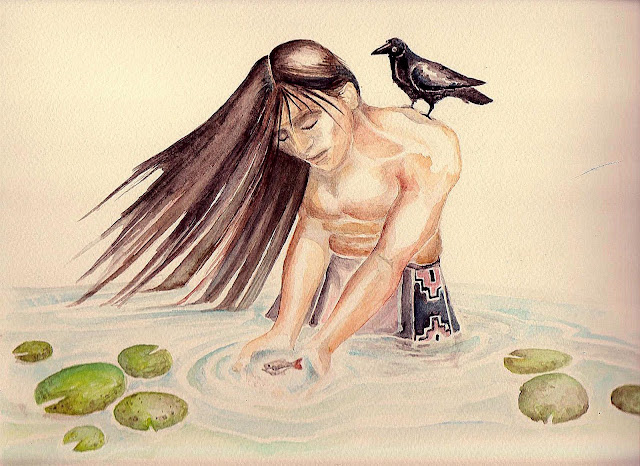
When a Feathabee passes from their homelands of Mirico to the Iridian Lands (Earth) they transform into many types of birds, including magpies, toucans, penguins, ibis, egrets, vultures, gannets and crows.
The indigenous peoples of the Americas have in some cases lived in close quarters with the Feathabees in the Lands of Mirico, and going back many grandfeathers, have been an integral part of the Miriconian culture.
Above we see Zahelo, a member of the Iridian 'Navajo' tribe, showing reverence to a creature in his Earthly lands. Leucus the Feathabee, disguised as a crow, is long-time friends with the Navajo people, and has lived in this form with the tribe for many years.
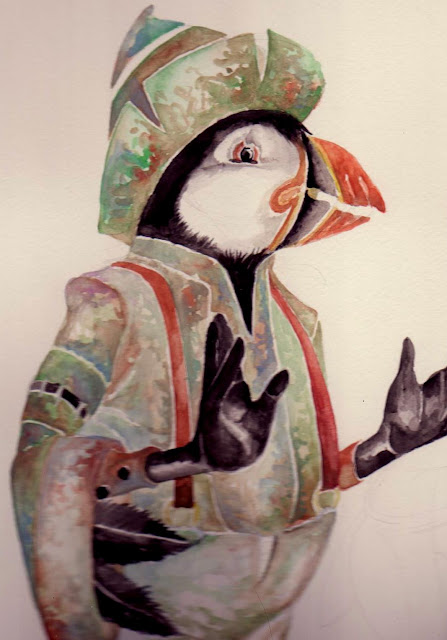
The Puffin Man
A detail from a larger painting where two Arctic Feathabees discuss the goings-on in a neighboring village...
Avarkha's Squid
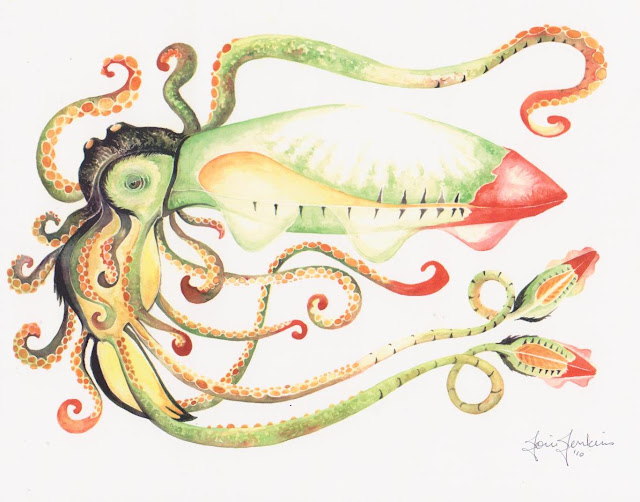
In the subtropics of Mirico around the islands of Iquliq (pronounced 'eee-koo-leek') there are a particular family of Cephalopod (discovered by the Feathabee explorer named Avarkha) that seek out what other creatures look like and then try on their appearance by changing color. The Avarkha's Squid will only do this in its young phase, however, and as it matures it will choose a look based on what colors and patterns it has attempted in the past. This gives rise to very unique and strange colorations, but Miriconian marine biologists are particularly fond of the Avarkha, as their markings make it easy to determine their oceanic range.
The Avarkha is also unusual in that it's usual mantle is split down the middle, opening to reveal a giant purple tongue, which it sticks out and flails to propel itself backwards from sudden danger.
The Carapacian

In the 'creatures of Mirico' series, this enormous crab (named Clawdette) is commonly known as a 'Grabble', though she and the rest of her kin would prefer to be called 'Carapacian', after the word 'carapace'.
Inhabiting the Antarctic regions as she does, Clawdette and her kind have a considerable growth of beautiful pale blue fur, which is mostly but not completely shed in warmer seasons. Since everything in the Antarctic regions is in limited supply, any shed fur is gathered and reused for other purposes, so it's not uncommon to see other Antarctic creatures sporting soft, pale blue tufts in their clothing.
Making a Game of It
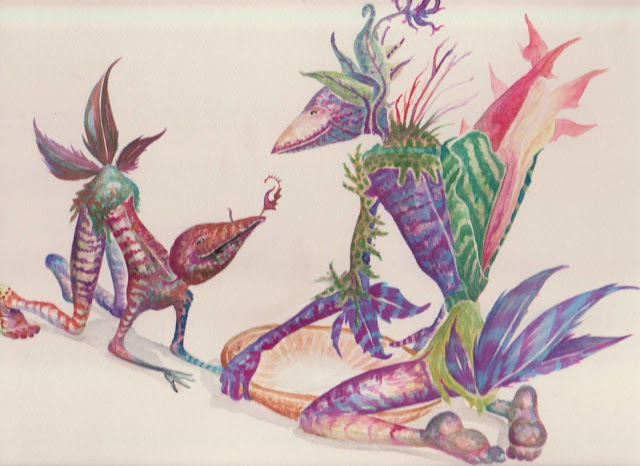
Another in the Onepalipan series, this image shows how the creatures of the Naku have taken to acting as mobile gardens by wearing a special moss-like cloth that promotes plant growth. By being a host for plants, Onepalipan Feathabees reap the benefits of higher oxygen levels in their immediate breathing space, as well as receiving the medicinal properties of the plants, which are released directly into the skin.
preparing for the race

While at first glance the racer Xioshael might appear to be wearing elaborate body paint, in fact he (with a helper or two) has plucked the short plumage covering most of his body into intricate patterns.
The ribbons and streamers he wears are actually a safety measure, for when Xioshael leaps across wide gaps in the annual race of his culture, the streamers will 'catch' on the rocks if he should slip, and prevent a fatal fall.

"You have something on your backpack..."
A cold-climateer, Yeanoek the Pengoon keeps the local seal's breathing holes clear of ice with her whale bone staff. Each section of fine embroidery on her incredible costume represents a particular specialization, such as boreal botany, solar tracking, search and rescue, and field medicine. A recent addition to her duties has been to scout for invasive species, such as crab and shark, in local waters.
"Would you care for a drink?"

"I only have fish cups - everything else is, ahem.... soiled at the moment..."
Ujynn the Falukian

Those unfamiliar with the outlying areas of the Lands of Mirico might not ever have met the Falukian clan, a highly refined ice culture living in the coldest regions. Among them are some of the Land of Mirico's highest minds, including arctic engineers, cold-botanists, marine biochemists and others. Of course, being this brainy has led to the saying 'Don't let your head outgrow the size of your tusks'.
Edharya and the Kekle

First in the recent series of human figure depictions within the Lands of Mirico, this image shows a young Miriconian human, named Edharya, wearing a sediment cloak, or bukheyut'h.
Edharya's people, the Kinnarit, also known as the Clan of Kinnar, have a deep human lineage in the Lands of Mirico. The Kinnarit are for the most part a peaceful, highly nomadic race well suited to the highly organic ways of life in the world of the Feathabees. But the Arahuans, a group of Miriconians staunchly against the existence of human beings in the Lands of Mirico, are always on the lookout. Edharya's costume is meant to make her blend in with the water and sedimentary rocks by which she passes on her way back from a foraging excursion through the night woods.
On her way back to the Kinnarit camp, Edharya has encountered a bioelectric kekle, an unusual insect found only in the Lands of Mirico...
Aeshoehl with Nuck and Q'nier

A Kinnarit girl looks after the little ones
Part of the 'Iridian' series, these paintings are meant to depict how some human beings, or Iridians, have interacted with Feathabees in the past (and in the present). The young man in the painting below, named Y'dar, has a long family history in the Lands of Mirico. You can tell this because, like his Feathabee friend Klo, Y'dar has eight toes instead of ten. The young girl in the painting above, named Aeshoehl (which means 'spirited' in old Bynsch) is looking after Nuck the twizlard and an orphaned Feathabee named Q'nier.
In the Basket

When the gathering is finished, a basket makes a good sled...

One of the earlier Feathabee paintings, this watercolor was inspired by a 17th century portrait of a nanny with her charges.
As a nanny myself, I find I am surrounded by a magical, frenetic sort of energy that has within it a calm, deeply centered love and trust. As I laid out the characters for this portrait I tried not only to capture this feeling, but also the persona of each child in my care, and to present items to the viewer that secretly link back to each child and my interactions with them.
As a nanny myself, I find I am surrounded by a magical, frenetic sort of energy that has within it a calm, deeply centered love and trust. As I laid out the characters for this portrait I tried not only to capture this feeling, but also the persona of each child in my care, and to present items to the viewer that secretly link back to each child and my interactions with them.
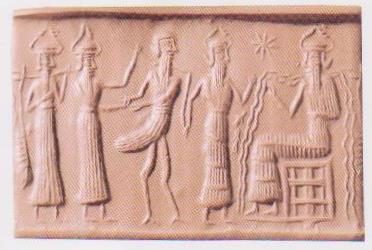
Possible Feathabee Cylinder Seal, 2250 BC
At first glance there seemed to be nothing unusual about this serpentine carving from Mesopotamia, or modern-day Iraq. Closer examination of the central figure reveals birdlike legs. The character, known as Anzu the bird man, is being presented to 'Ea' by what are presumed to be two godlike captors. While Anzu is quite birdlike in this carving, he has also been represented with characteristics of the eagle and the lion.

When I came upon these lovely blown glass beads, I had not until that time hit upon the idea of using such items for 'eyes' in my dolls. But examining the variety of patterns, and considering the depth and visual interest such glass beads could potentially create, I felt I should explore the possibilities...
A Possible Feathabee Depiction by Remedios Varo, 1951
In her charming painting 'Jardin d'amour' (Garden of Love) surrealist Remedios Varo hints at a possible encounter with a member of the Bluebard clan.
Swords, as the one shown here, are a rare sight in the Lands of Mirico, and are usually displayed as relics or traded between Feathabees with a particular curiosity regarding human customs. In some regions of the Lands of Mirico possession of such an artifact could lead to confiscation of the 'contraband' item, and the possessor is usually suspected as a human (or Iridian) sympathizer. Because many Feathabees have witnessed acts of violence on the part of human beings, interaction with them is held by some as a foolish or dangerous gesture.
Swords, as the one shown here, are a rare sight in the Lands of Mirico, and are usually displayed as relics or traded between Feathabees with a particular curiosity regarding human customs. In some regions of the Lands of Mirico possession of such an artifact could lead to confiscation of the 'contraband' item, and the possessor is usually suspected as a human (or Iridian) sympathizer. Because many Feathabees have witnessed acts of violence on the part of human beings, interaction with them is held by some as a foolish or dangerous gesture.
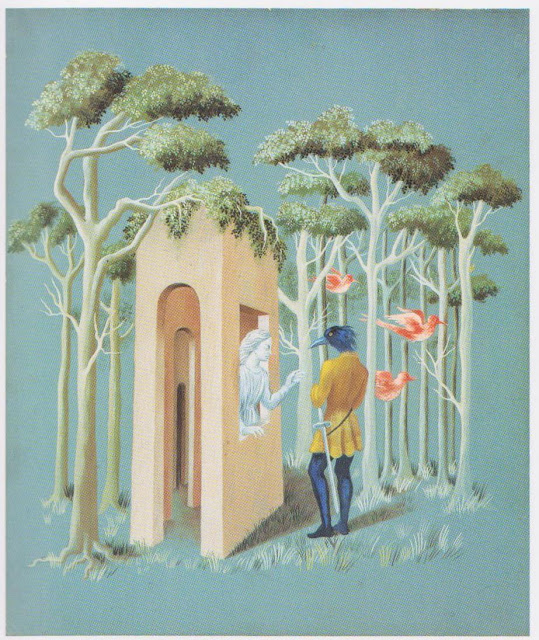
uncle kettles
budge and orly
The double-portrait above was one of the earliest Feathabee images I attempted, and in retrospect one of the more fun.
A Chance Meeting
Recently, as I stood in the checkout line at Whole Foods Market in Ann Arbor I started up a conversation with a warm and friendly gentleman by the name of James Britt, who stood just ahead of me in line.
When James inquired about what I did for a living I told him, "Well, I've discovered this world of strange and wonderful creatures, and I'm busy bringing them to life. I don't know if I'm creating them, or if they're creating me at this point - Maybe it's both."
He shook a finger at me, smiled broadly and said "Ah, you've discovered a delusion that can support you!"
I had never thought about it that way before, but I love the idea. Thanks, James!
Settling into the flowers with a good book...
the shorehouse and welcome center

When entering the port city of Chilkin, newcomers will usually be dropped off at the Napaloe Shorehouse, where you can acquire not only a bit of history in the Museum upstairs, but also maps, rations and a local guide who will see you off anywhere in the Chilkin city limits.
twilow and myrk the twizlard

Twilow is seen here repelling into the caves of Creatoli, only to have a twizlard fall from on high in the canopy onto the soft tuft of his tail.
"It's a good thing my tail was just there," Twilow laughed.
"It's a good thing my tail was just there," Twilow laughed.
the full sketch of zarkola's vessel
detail of the larboard side
Zarkola's Bioelectric Flying Machine
Being a rather eccentric Feathabee inventor living and working in the Lands of Mirico, Zarkola drew up these sketches a long time before he became an accomplished builder of flying machines. His early crafts were all fairly successful, but none so much as the bioelectric vessels he constructed in his later years.
As all Feathabees have a symbiosis with nature, and since Zarkola especially loved insects, he designed his craft after the creatures that actually power the machine itself. The formula that Zarkola has scribbled to the left in the detail photo is actually the formula for electrical exchange conservation, which is part of what causes his bioelectric craft to fly. Zarkola's distant relatives passed on this conservation formula to him directly from Georg Ohm, as the German physicist visited the Lands of Mirico in the Iridian year of 1850.
As all Feathabees have a symbiosis with nature, and since Zarkola especially loved insects, he designed his craft after the creatures that actually power the machine itself. The formula that Zarkola has scribbled to the left in the detail photo is actually the formula for electrical exchange conservation, which is part of what causes his bioelectric craft to fly. Zarkola's distant relatives passed on this conservation formula to him directly from Georg Ohm, as the German physicist visited the Lands of Mirico in the Iridian year of 1850.
Oraela Art Doll

The puppets I've created thus far have been very spontaneous, created both by hand-sewing and with the help of a hand-me-down Singer sewing machine that used to belong to my grandmother. I love the simplicity and history of the machine, and can rely on it for almost all my stitching needs. In a perfect world I would like to have a foot-pedal sewing machine, so that I myself create the energy needed, rather than using electricity.
Jimiro and Dingle

Part of the 'Magic Hat' story, this painting shows Jimiro putting on his boots and preparing to go outside with his older brother's hat. Dingle, his sweet and intelligent cog friend, is suggesting in his own way that it might be a better idea to play with his doll instead...
I'la Art Doll

When I first started sculpting Feathabees with Sculpey I didn't use glass or wooden eyes. This doll originally had a solid clay head with eyes painted into the sockets, which admittedly didn't have as much 'dazzle' as the more realistic glass eyes do. When I had gone through enough dolls to know how to make them more efficiently and more realistically, I gave the doll a new face. When I look at pictures of the old doll with its former head it still has something, but the translation of persona is so much more profound with a deeper countenance in the eyes.
Out on the Limb
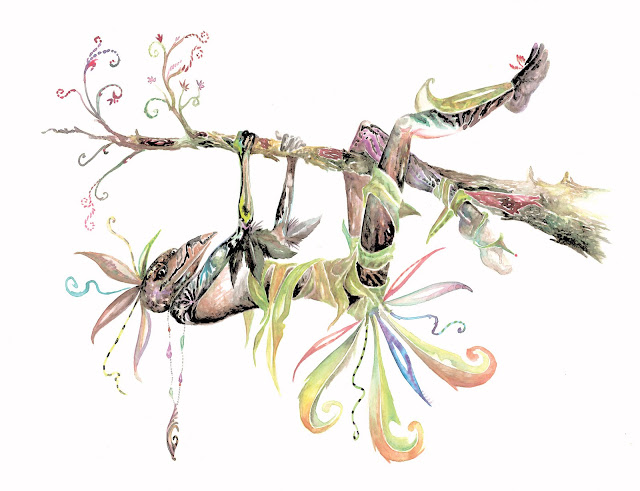
It was with this watercolor that I felt I crossed over a significant threshold - both in technique and in subject matter. I came across a wonderful book about remote African tribes that decorate themselves with flowers, leaves, gourds, grasses and body paint. This book shook my foundations as an artist, and after nearly 15 years of story and character development, it finally showed me what a particular group of characters in the Land of Mirico would look like, from a Feathabee perspective of course.
The completed doll with cape

A closeup of hand-sculpted boots

This is a festival costume for the Day of Giving

One of my more recent dolls, I created this character as a result of the discovery of an unusual material - Nepalese recycled sari silk ribbon. Tied together in long durable strips made of multiple patterns, the ribbon gave me the idea to 'wrap' a character in it entirely. I also used handmade wool nubs sewn onto the rim of hand-cut birch bark buttons, and took apart a second-hand feather duster to create wings and a tail.
The last item that came along for this character was a scarf from the weekly Kiwanis sale in Ann Arbor. When I got home with the scarf I set it aside at first, intending to let it be inspiration for a new doll. But when the doll already hanging on the wall got a glimpse of it, he seemed to say "Let me try it on!" It was, needless to say, the icing on the cake.
The last item that came along for this character was a scarf from the weekly Kiwanis sale in Ann Arbor. When I got home with the scarf I set it aside at first, intending to let it be inspiration for a new doll. But when the doll already hanging on the wall got a glimpse of it, he seemed to say "Let me try it on!" It was, needless to say, the icing on the cake.
Racer preparing for the Stalagmites

Recently when I was listening to the soundtrack for 'Master and Commander' I heard a track that instantly gave me a vivid, spine-tingling image of a Feathabee race across stalagmites. A few weeks prior I had already seen a vision of a character crouched at a cliff side with ribbons and banners whipping back in the wind, but I couldn't yet 'see' what the purpose or intent of the character was. When the soundtrack showed me the image of the racers dashing lithely across dangerous distances to leap from one stalagmite to another I suddenly put the previous image and the race idea together.
Sala with the Flying Snakes, the Sleathers

Since there have been human interactions with the Feathabees for as long as can be remembered it is not uncommon to see an Iridian (or Earthly) object in the Lands of Mirico. Sala the musician particularly loves his violin, but in the Lands of Mirico the sound of the instrument is quite different.

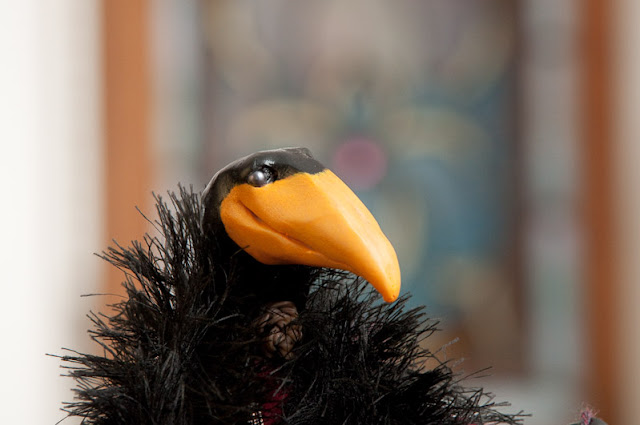
A closeup from a recent Feathabees photo shoot, this is my dear friend Zirk.
Polkin and Two Wees

An Excerpt from the story poem Q’tir ataqu Aqu’ta
– Upon the Unexpected Road
On quite an uneventful day, in quite an uneventful way
Walked I within a forest near, and this is what I heard it say:
“Annuk’ha qu’ andonad - On’peqin amad-odod.”
And inquiring of the nearest tree to speak again - It gave a nod!
And now it spoke, the forest deep as if awaking from a sleep
“Welcome, stand among us now and precious do our secrets keep.”
“You’ve left behind your Earthly lands and things made all by human hands
Beyond these boughs held up in joy a place of wondrous whimsy stands.”
“Indeed, said I, as not aloud have I talked with bark and branches proud
Into dreams have now I strayed or with new vision am endowed?”
The trees they laughed a chorus all and gave me pause to feel quite small
“You are not changed,” the trees replied “But now is veil that once was wall.
You sought us in your very heart though knew you not the play or part
The way is made for few to pass and in yourself you set the chart.
And now come in, and hearken close to what the water speaks and knows
And stone and wind do find as well a reason for the path they chose.”
– Upon the Unexpected Road
On quite an uneventful day, in quite an uneventful way
Walked I within a forest near, and this is what I heard it say:
“Annuk’ha qu’ andonad - On’peqin amad-odod.”
And inquiring of the nearest tree to speak again - It gave a nod!
And now it spoke, the forest deep as if awaking from a sleep
“Welcome, stand among us now and precious do our secrets keep.”
“You’ve left behind your Earthly lands and things made all by human hands
Beyond these boughs held up in joy a place of wondrous whimsy stands.”
“Indeed, said I, as not aloud have I talked with bark and branches proud
Into dreams have now I strayed or with new vision am endowed?”
The trees they laughed a chorus all and gave me pause to feel quite small
“You are not changed,” the trees replied “But now is veil that once was wall.
You sought us in your very heart though knew you not the play or part
The way is made for few to pass and in yourself you set the chart.
And now come in, and hearken close to what the water speaks and knows
And stone and wind do find as well a reason for the path they chose.”
Tending to the Wees
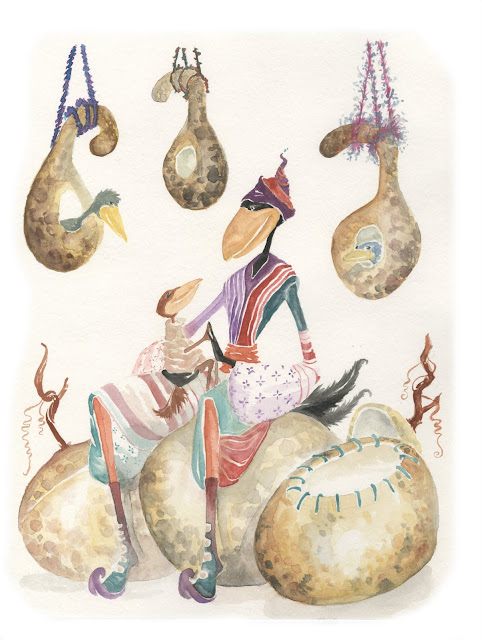
Here we see a common nursery, where an older bird keeps watch on the gourd nests and tends to the little ones needing attention.
A Gourd Nest
Courtesy of Ed and Linda Lock
When a dear friend of mine introduced me to the wonderful world of gourds, I had many immediate ideas about what to do with them - With her help I was able to create small organic shelters for some of my Feathabees, including this one. Chook, the Feathabee inside, is still only a few moons old. Soon he'll climb out of the gourd on his own and start wreaking havoc elsewhere...
the early workspace

In the early days of Feathabee creation a few years ago, this was the typical look of my workspace. The doll in the foreground has gone through several evolutions, heads, poses and personas.
a feathabee meteorologist

This Feathabee is a meteorologist of sorts, having collaborated with the local glassblower to create a portable and reliable device for measuring everything from dew point and barometric pressure to pollen count and ozone level.

A lot of my recent three-dimensional dolls have ended up being wall-hangings because of the fact that there are no doll stands tall enough to support their length. Such was the case with this rather intense looking fellow, who happens to be offering a plennycress blessing.

The funny story behind this doll was a bit of a learning experience for me - I was setting up at the Ann Arbor Artisans' Market as usual, and had set out a number of my more recent dolls for people to view. I had spent the previous day taking apart the doll shown in the photo above, because I had made enough dolls by then to learn how to go back and make him better. All that was left of him at the time was a scarf-poncho, one polymer hand and his head on a dowel. But someone saw him peeking out from a bin beneath the table and said "Who is that? I want him!"
"But he isn't finished!" I laughed, and lifted up the poncho to show the customer the bare bones of the situation.
"Well, when will you be finished with him, then?" the customer replied.
"Next week?" I said, crossing my fingers I could get it done in that amount of time. I did, and the doll now has a happy home (other than mine). The experience showed me that not everyone needs a certain presentation to be caught pleasantly by the right character.
"But he isn't finished!" I laughed, and lifted up the poncho to show the customer the bare bones of the situation.
"Well, when will you be finished with him, then?" the customer replied.
"Next week?" I said, crossing my fingers I could get it done in that amount of time. I did, and the doll now has a happy home (other than mine). The experience showed me that not everyone needs a certain presentation to be caught pleasantly by the right character.

This doll was actually inspired by two items - an antique hat pin (which became her scepter) and a wool scarf from the Salvation Army. Several times I saw the scarf in my goings-about at the local thrift shop, but I always passed it by, seeing it as 'the wrong color for me'. Once I shifted my perception of the object I suddenly realized it didn't matter if it wasn't right for me - it was perfect for a Feathabee!
Performing the Fire Suite
One of the earliest Feathabees paintings, Valara seemed to just magically appear, and she continues to be a favorite among friends, family and fans.
From head to toe

The details are often the most fun for me, and in this case, since the eyes of Miss Parrot are wood instead of the usual glass, I experienced quite a magic moment when I painted in her eyes.
It was as if, suddenly, she was 'there'.
It was as if, suddenly, she was 'there'.
the parrot woman
The impetus of this doll was actually a combination of a felted wool cowl scarf (intended for human use) and the bits of shell taken from a second-hand bracelet.
Two Onepalipans of the Naku

These Onepalipan Feathabees who sat specifically for these portraits were very regal, patient and warm. After I sketched them they admitted to being the spiritual leaders of their particular region. The uppermost figure is Abfosam, the Maso or 'Guide' of the Onepalipan Feathabees. His lifelong partner and 'Dream-shaper', Hyurendi, was especially graceful and beautiful, and gifted me with a Palanq'u flower as I left.
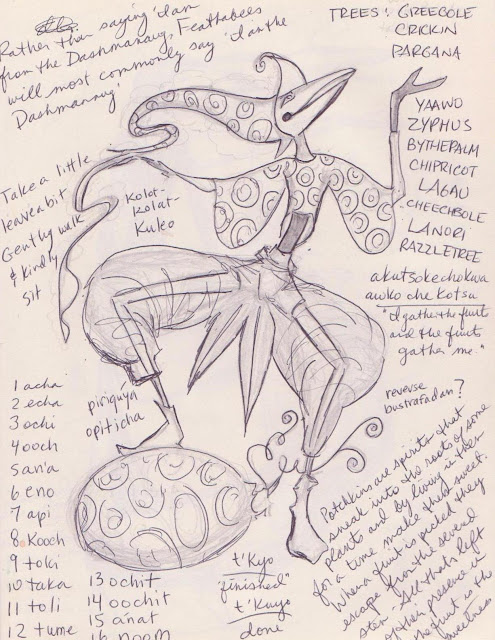
Directly from my journal
The funny thing about the way I create is the randomness of the ideas and how they arrive. On any given page of my journal you can find snippets of dialogue, sayings, lists of local flora and fauna, poems, song lyrics, sketches and, in the case of the page shown, even numbers translated from a Feathabee language.
The funny thing about the way I create is the randomness of the ideas and how they arrive. On any given page of my journal you can find snippets of dialogue, sayings, lists of local flora and fauna, poems, song lyrics, sketches and, in the case of the page shown, even numbers translated from a Feathabee language.
Mantis Woman

This Mantisora doll started out as an owl, but when I sculpted the Mantis head I fell in love with it so much that it shifted my doll-building plans. Some people react with fear to this doll, which I can understand and respect. But part of the reason I sculpt such dolls is to make us question why we fear the things we do, and to present a potentially new perspective to challenge the assumptions and expectations we may be embracing too tightly.
a feathabee begins

The first stage of building a cloth-and-clay doll is making the head, hands and feet, or boots. I typically sculpt the head and boots on a structure of tightly packed aluminum foil to both keep the body parts light and minimize the amount of clay used for each figure.
Glass, wood or button eyes are set into the head for realism and an eye socket is built around this to create lids. The most interesting thing about this part of the process is that even the most minute change of shape in the eyelid completely changes the personality and mood of the character.
the Lizabard Doll
On display at the Washtenaw Whole Foods Market in Ann Arbor, this charming Lizachap features an African porcupine quill scepter. His tail was especially fun to sculpt.
A relatively new development in the Feathabee book series is the handmade paper version. Books One, Two and Three are all available in hand-bound paper, and although the printed material and text within each book in the series remains the same, each book is completely unique.
This Book One cover features hand-picked driftwood, several different kinds of handmade paper and found yarns woven through the paper.
driftwood book cover
a petroglyph and explanation
an inside peek
Look for books like this one at http://www.etsy.com/shop/jorie74
siltweed closeup
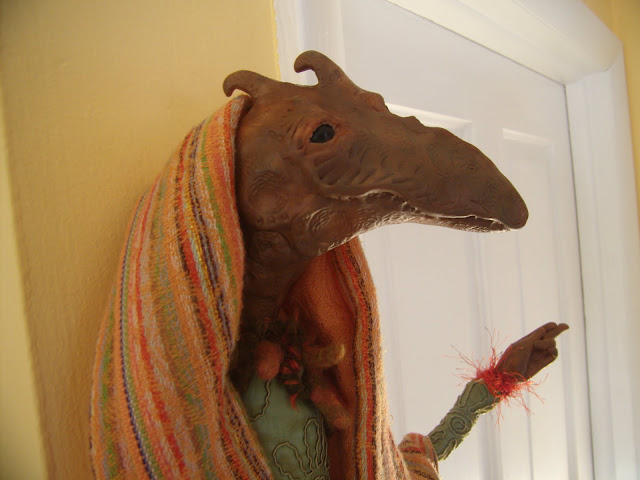
siltweed doll
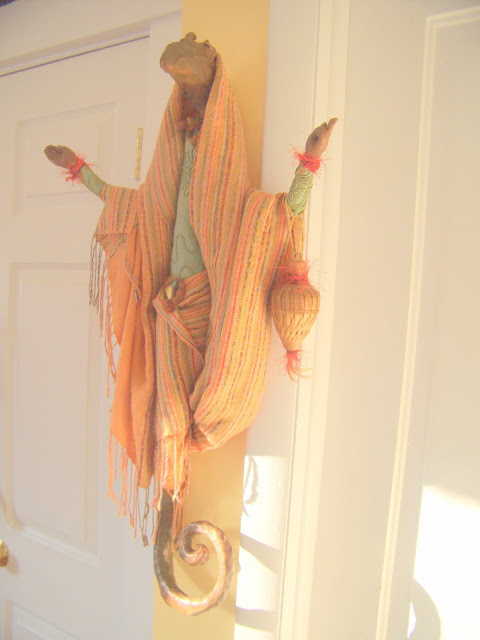
In a more recent experiment in doll-making I've ventured out into the characters 'beyond' the Feathabees, or the friends that also inhabit the world that the Feathbees introduced me to. This 'siltweed shoehorn', shown in her land phase, apart from the Polymer clay of her head, hands and tail, was completely constructed of found and recycled materials.
A new friend comes together
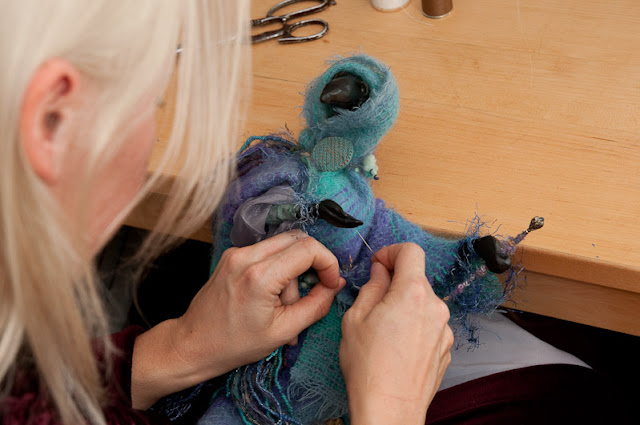
home studio
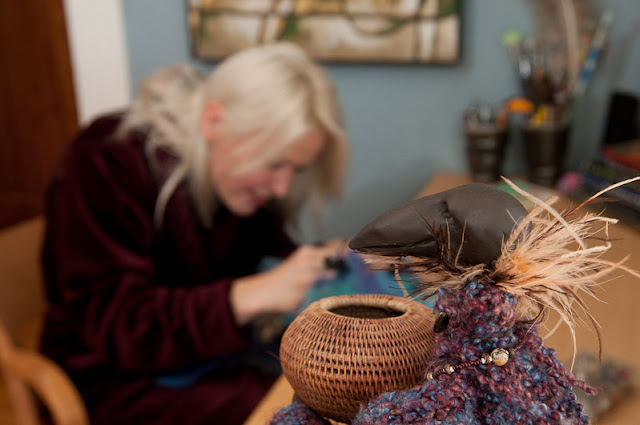
At work in my Ann Arbor studio, with a friend looking on.
Three Feathabees
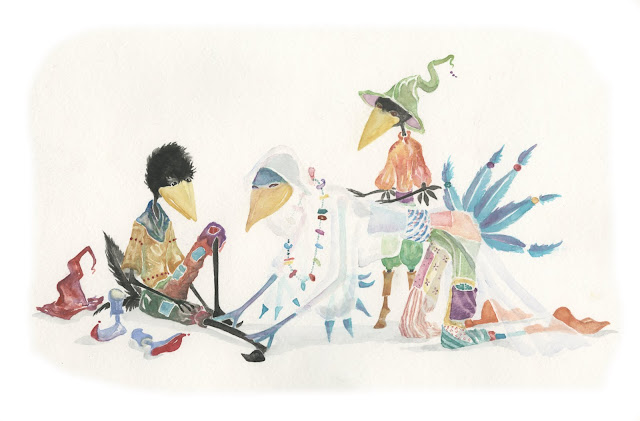
I enjoy creating vignettes in my paintings, but like to leave enough about the scenario ambiguous so that different people can interpret the situation in a number of ways.
Kettles Puppet Doll

Kettles
The first soft-and-sculpted doll I ever made, Kettles is also a puppet and often makes live appearances at Feathabee shows. He has also been in the film 'Art House'.
The first soft-and-sculpted doll I ever made, Kettles is also a puppet and often makes live appearances at Feathabee shows. He has also been in the film 'Art House'.
The Oraphau Pirn

The Pirn
From the upcoming 'Fables, Myths and Folklore' book in the Feathabee Series, this illustration of a caravan lanten, with caterpillar and moth designs embellished with palumar stone, shows the beautiful handiwork often seen in the Lands of Mirico.
tying his laces

Twilow
Sometimes a piece of driftwood, like this one I found years ago in the Pacific Northwest, will invite me to sculpt a character based on something in the shape of the wood. In this case the driftwood had a niche in it that just begged for a leg tucked into it. So I made a wire armature based on the driftwood, and Twilow, seen here tying his laces before a cave excursion, emerged...
Sometimes a piece of driftwood, like this one I found years ago in the Pacific Northwest, will invite me to sculpt a character based on something in the shape of the wood. In this case the driftwood had a niche in it that just begged for a leg tucked into it. So I made a wire armature based on the driftwood, and Twilow, seen here tying his laces before a cave excursion, emerged...
The water gatherer
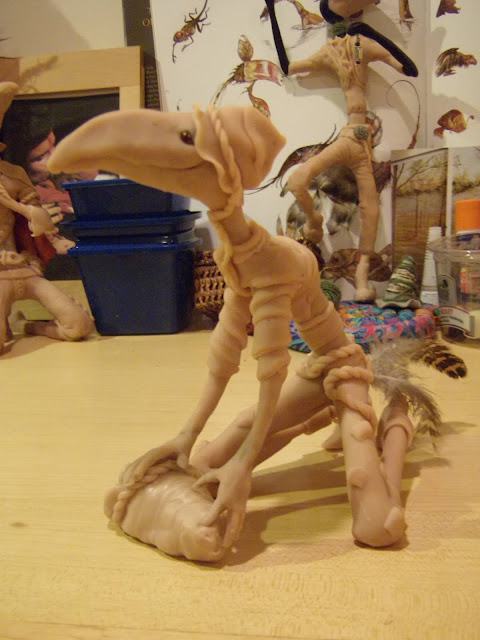
The first thing I do when I'm going to sculpt a new figure in polymer clay is to sketch the pose in 'stick figure'. Then I'll act out the pose myself to discover what the skeletal structure of the figure is actually doing. I'll ask myself "What is the angle of my left hip joint?" or "How much pressure is my elbow exerting on my knee in this position?" That tells me what the muscles of the figure are doing. Then I build a wire armature and begin laying clay onto it.
kicking back
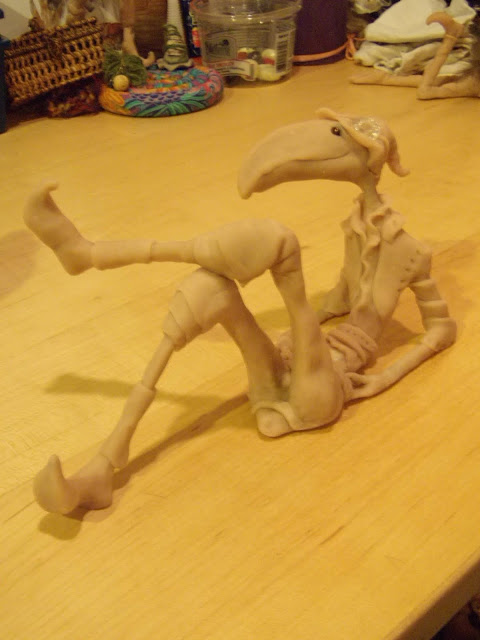
Work in Progress
This is typically how a fully sculpted Feathbee looks in the soft clay phase, before baking.
crickle the basketer
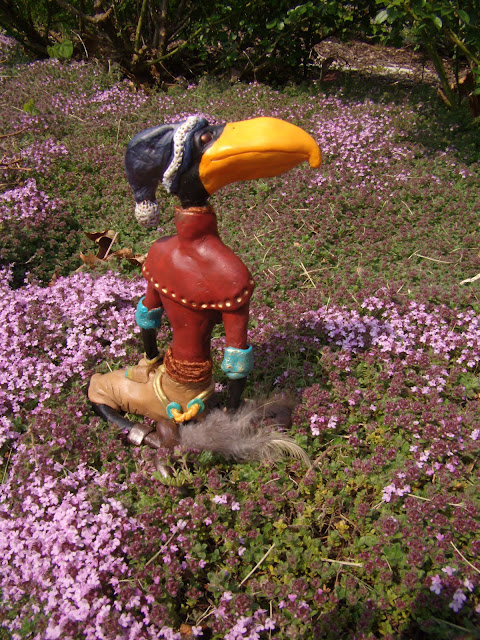
Crickle
The blossoms along the sea cliffs in the Aki region are wonderful to bask in, their scent a magical sweetness that lures for miles.
After a day of basket weaving, Crickle takes a stroll out to the ledge and hunkers down in the ground-clinging creepers.
The blossoms along the sea cliffs in the Aki region are wonderful to bask in, their scent a magical sweetness that lures for miles.
After a day of basket weaving, Crickle takes a stroll out to the ledge and hunkers down in the ground-clinging creepers.
Gourd courtesy of Ed and Linda Lock

Gourd Nests
It's common for Feathabees to keep their wees in kekle gourds, especially in the hatching phase.
Zwindar

From the hand of Zwindar, the Miriconian Guardian of the Door of And'yolek
*doors, in the Lands of Mirico, refer to thresholds allowing passage between Iridia, or Earth, and the Feathabee lands.
... Twas on that mornin' that I woke before the others, a'feelin of somethin unresolved in the deeps o'me. Tho it's not uncommon that I sense the day a'comin on as I have a way of seein' the dawn without me lookin' eyes, on this mornin somethin felt different as if the sky was callin to me with its many voices.
When I rose it was cool and still, the fog yet asleep against the green of the ground. The wind whispered somethin to me about newcomers, and I hadn't seen the likes of them in too long a while. Not many of the Iridians brave the comin here any longer, or they just don't have the sort'a eyes to see us anymore.
But the trail leadin away into the brush spoke to me, seemin to say I should take it. So off I went. Beyond I remembered there being a clearing of sorts, a ridge lookin out over the valley behind so I thought I would seek that out, and that from there I might better hear what the mornin wished to tell me.
The leaves 'round the path were dense and creepers heavy with delicate pale blue tepherna blossoms arched across, catchin their pesky little burrs in my peppleboots. In the thickets all around I could hear the dozin' zetchums, still humming in a lazy harmony even in their sleep. Lookin up I could see the Beable moths a'clingin to the underside of every Pamble leaf. They would wake soon, and then the forest would be alive with the whir and flutter of their uncountable wings.
As I reached the ridge and looked out upon the valley stretchin out beyond, it was me feet that stopped at first, then heart that stopped a'second. For standin there and lookin at me with wide and wondered eyes was a Child of Iridia, a boy of about nine Settling Seasons old. By the look upon his face it was the first time ever he'd set foot in the Lands of Mirico, and the twinge of fear that shook him when I appeared told me he'd not seen the likes a'me before. Bein' a tall creature meself, I knelt to be a bit closer to his eye level and stretched out me hand, waitin for the child to make the choice his own.
A Yaawo Tree and Alenda the Sun
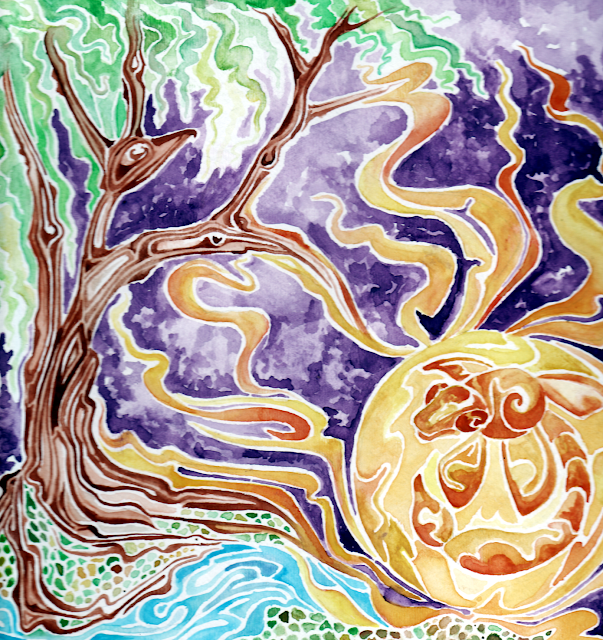
THE AKI TREE MIGRATION
The Aki trees of the Central temperate regions of the Lands of Mirico are dark-brown-to-black in bark coloration, with enormous deep blue leaves laced through with veins of dark purple and burgundy, often edged with bright yellow. Their brances divide in series of three and each branch will produce no more than three leaves at a time. Being deciduous, the Aki leaves change to pale green in the fall, the veining changing to yellow and faint orange at the leaf tip. Aki leaves are quite useful once dried, as their veins are large enough to be used as vials, storage tubes, and even pirns (lanterns). Aki bark is incredibly tough and can actually be used as a cutting tool on many softer materials. The wood, which grows in a spiral rather than a 'ring' pattern, is faintly blue with a slightly silver and irridescent quality.
Apart from being the tallest and the second-longest living trees in all the Lands of Mirico (second only to the Razzletree) the Aki are also a marvel of Miriconian Nature in that they have the unique ability to uproot themselves and take flight. This usually occurs in the form of a group migration when the biological balance in which the Aki live is compromised.
When the trees take flight they usually do so in a rather haphazard formation, though some 'stands' (or flocks) of migrating trees have been observed flying in a markedly diamond formation. They see where they are going by way of a single giant 'eye' set in the root ball of their massive trunk.
At times the trees will see a spot which from the air seems suitable, but in fact the PH balance of the soil there will be too acidic, or the climate will prove too extreme. Thus, whole Aki stands will at times be lost, since the tremendous expenditure of energy required to migrate prevents the trees from doing so often.
Though it is not known how a specific site is 'chosen' by the migrating trees, the arrival of an Aki forest is truly a sight to behold. When they have chosen a landing site they begin to hover in place and then slowly spin, their root systems pulling inward to create a corkscrew shape. Spinning faster and faster in the air, they suddenly lift their branches, pointing their leaves nearly straight up in the air and then drop from the sky, screwing themselves into the new soil by way of their spiraling motion.
Brynn Feathabee
Some of the most fun I've had in realizing the realms of the Feathabees is finding odd objects and organic items that somehow seem to 'come from' the Lands of Mirico. When a fellow artist introduced me to some fantastic gourds she and her father had worked on I was immediately smitten. Here was a beautiful, simple and visually stunning natural home for many of the Feathabees.
Tonquin anticipates the rain

Who was that masked bird?
A fellow artist and friend asked me to sculpt this and another little doll for her as companions to the series of Feathabees books she was ordering for her grandchildren.
A Doll Built on Commission

This watercolor painting of the wandering minstrel known as Blackbard, was the first Feathabee ever to emerge to the artist.
Blackbard has a sinuous singing voice, loves the Bythe flower (shown) and usually sleeps still wearing his large pepplemoss hat.
Blackbard Feathabee
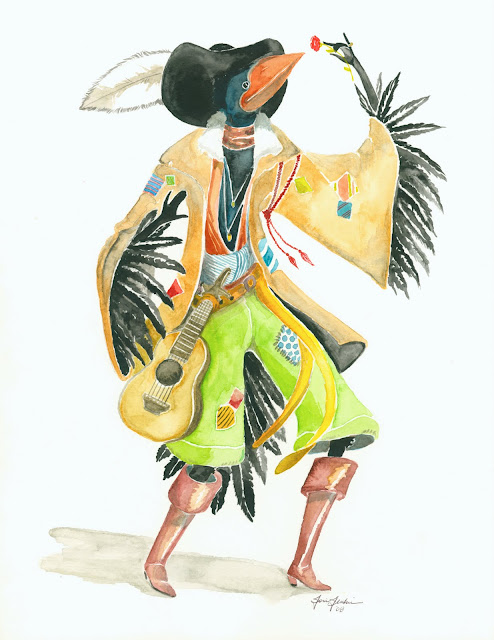
The Dance of Light
In the time of year when the Beablemoths first emerge, there is an almost constant faint blue glow about the woods where they are born. In conjunction with this, there is usually some sort of celebration (going by different names and customs based on the region and culture) held to welcome the new insects.
Here, Dola Feathabee performs a 'pirn' or lantern dance, lulling a newborn Beable larvae to sleep.
Dola and the Pirn Dance
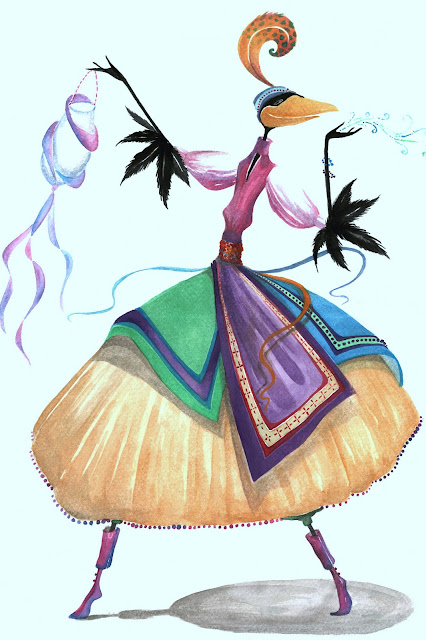
Account of the Yirdil
THE YIRDIL
By far the oldest known stronghold of civilization in the Lands of Mirico, the Lands Yirdil are widely unknown. In some regions of Mirico Yirdil itself is categorized as myth, bardspeak or heresay. The location is highly sacred and tends only to be visited by outsiders who have either been called upon or who have sought out the region for the purpose of a proven pilgrimage. Being an island outwardly composed of slippery, sheer rock, the stunning flora and fauna of the Yirdil are largely endemic and fairly vulnerable.
Passing into the Isle of the Yirdil one can approach only by way of the Door of Kekajakawa, entering through a treacherous channel flanked by barbs of submerged palumar and spires of kimbram crystal. Beyond, cut through by a swiftly rushing froth of pure water known as the Ith'kuer Strait, stands a narrow fjord of soaringly vertical palumar stone. So deeply blue is this stone that it is as if the surrounding seas have solidified to form an impenetrable fortress.
Passing into the Ith'kuer there stand an ancient host of enormous stone figures, hewn as if emerging from the rock itself. With their feet held firm in the onward waters of the Strait, eight figures sentry either side of the upsoaring stone walls. Their outreaching arms extend to a counterpart figure, creating a series of arced bridges. On the left stand the figures of Iridian lineage, on the right, those of the Miriconian lands. Some of the bridges have been sabotaged, but several are still sound and are used by the Yirdil as passage over the high gorge of the Ith'kuer.
The Iridian's once-grand stone heads have long ago been cast down and destroyed, a sad and lasting mark of resistance and protest against the presence of Iridians in the Lands of Mirico. Even the features of the Miriconian figures have been badly defaced, hacked and marred as if to say that those who would come to an accord with Iridians are naught but fools.
Thabaskan the Healer
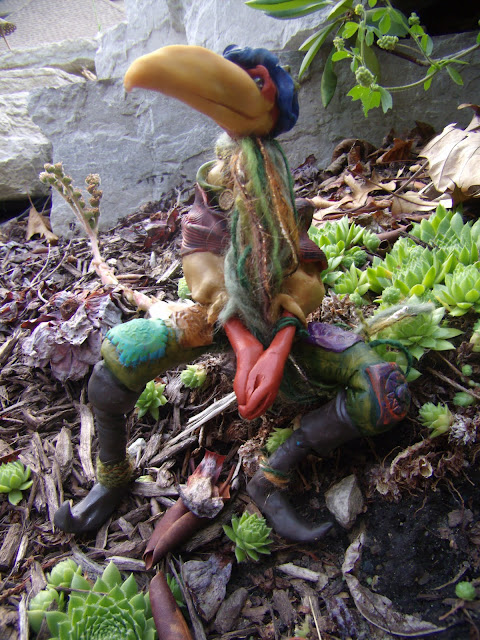
Erk-Merregen
I came upon this rather dashing fellow in the far South regions known as Arkhalorko. He had a heavy, drawling accent very similar to that of the Iridians known as Australians and charmed me with his easy smile and deep, patient eyes.
It turns out that Erk-Merregen works primarily as an Earthspeaker in his lands, listening to the concerns and queries of his plant and animal friends and relating such issues to a panel of Feathabee conservationists and ecologists.
Erk-Merregen Out and About
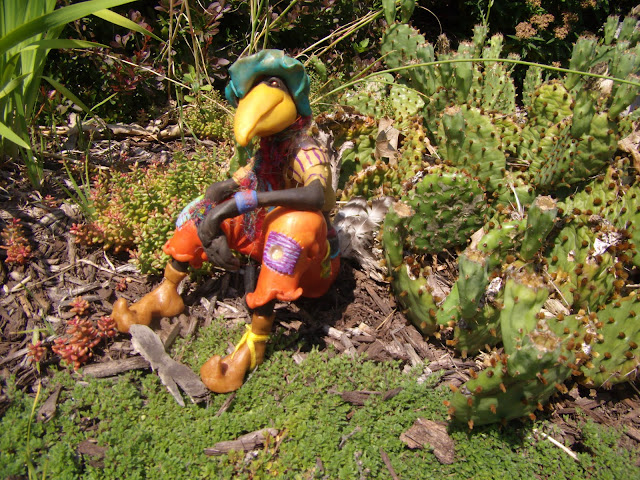
One of the earliest figures I've ever sculpted, Pim, the smaller of these two characters, is actually only about one-and-a-half inches tall.
Kala and Pim

When visiting the Naku Islands in the Zun Sea I was surprised at how imaginative the natives of the region were when decorating themselves with mud, flowers, seed pods, branches and leaves. The characters below are the sort you might see while traveling through the Zun, and they tend to change their ornamentation on a daily basis. Aside from being a lovely decoration, their mud and leaf clothing also keeps their bodies cool in the tropical climate.
A Male and Female Onepalipan
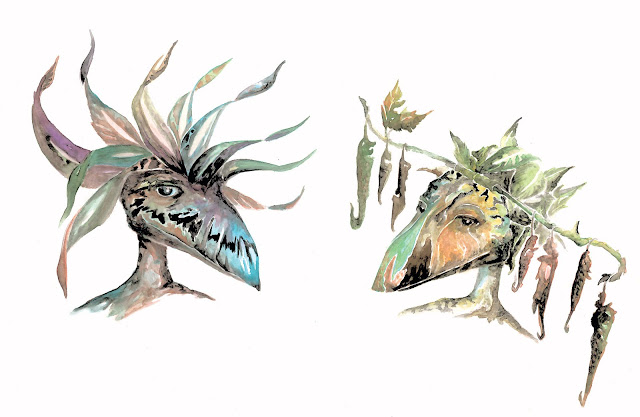
Creatures of the Naku
The very colorful Feathabees of the Naku Islands are extremely agile and highly flexible. They can 'walk up' most trees that are at a slight angle and pretzel themselves into the most graceful, almost impossible poses.
This Onapalipan is up in the treetops 'signaling' to one of his friends with an iridescent spinning stone.
This Onapalipan is up in the treetops 'signaling' to one of his friends with an iridescent spinning stone.
Onepalipan hanging about
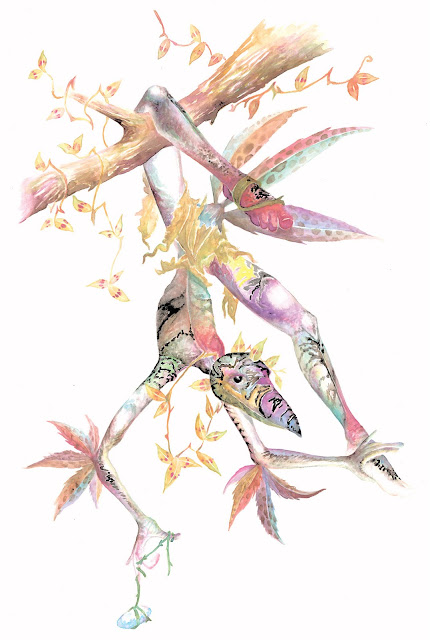
detail of a recent doll made completely of upcycled materials

At times when I build a doll they will remain unfinished for quite a while, waiting for just the right scarf, prop, shade of fabric (or muse) to bring them completely to life. Each doll is completely unique, with glass or wooden eyes, vintage buttons, found objects and upcycled materials combining to bring out their eccentric persona.
Two Feathabee Dolls

A custom commissioned doll with birch bark book

The Feathabees believe that fruit becomes sweet with the help of spirits called 'potchkins' who sneak into certain plants through the roots, live inside the fruit and then 'escape' through the cut stem when the fruits are harvested. Since no one knows what the potchkins look like the Feathabees have come up with many likenesses for them, including the one below.
Dressed as a Potchkin for the annual Potchstomp festival, this Feathabee embodies in his costume the whimsicality and sweetness of many of the characters in the Lands of Mirico.
potchkin

Lynwyk the Plennycresser
After a long but pleasant day of gathering plennycress grass, Lynwyk pauses on a soft and mossy spot to take in a bit of the evening air.
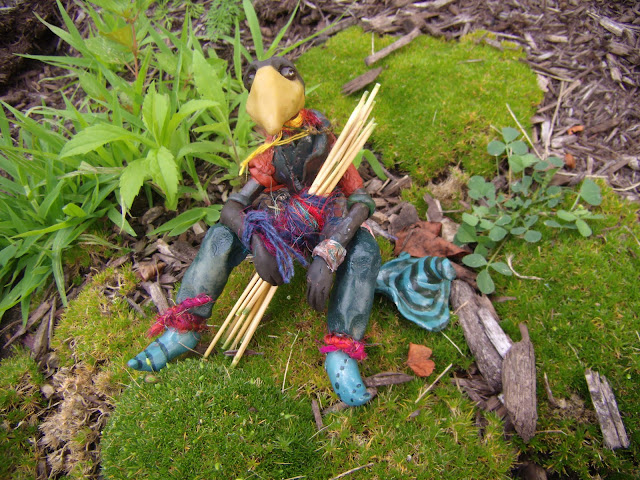
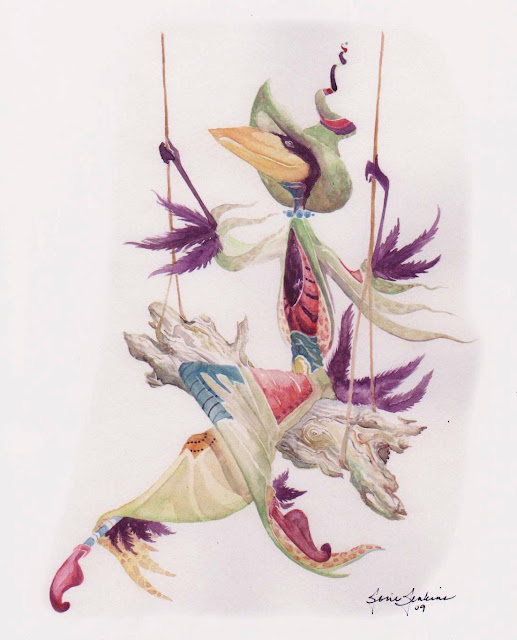
Zaku Feathabee on Pamblewood Swing
The Feathabees of the Southern Hemisphere are as tropical in appearance as the flora and fauna that surrounds them. Like their Northern brethren the Southies love the sensation of flight but can't fly, so they often construct swings, like this one, and spend hours lolling up in the canopy.
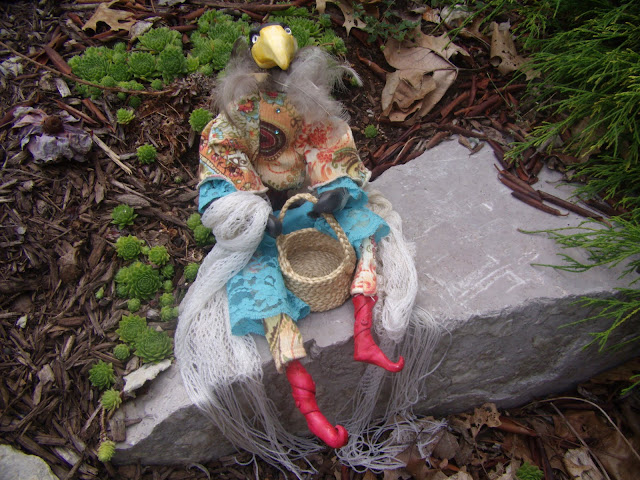
Posable Feathabee Dolls
When I first started making dolls I did it for the purpose of creating three-dimensional ambassadors for my two-dimensional work. Dolls like I'la, pictured above, have now become a staple of my creative process, and allow me to work in areas of craft that I rarely ventured into before.
I'la can be posed on a doll stand, but has a long dowel running through her body so that her head can move back and forth in a 'puppet' motion. Her arms and legs are bendable as well, allowing her to sit in many different positions
I'la can be posed on a doll stand, but has a long dowel running through her body so that her head can move back and forth in a 'puppet' motion. Her arms and legs are bendable as well, allowing her to sit in many different positions
UPCOMING SHOWS AND GALLERY EXHIBITS
And now for a bit of local and potentially interesting news - The Earth Arts Gallery in Ypsilanti, Michigan, home of a current Feathabees exhibit, will be closing its doors for good today. The silver thread of course is that the gallery will be moving to 116 E. Washington Street in Ann Arbor and will be open for business very soon.
Other galleries currently featuring the Feathabees include The Wild Acorn in Manchester, Michigan and Eclectica Gallery in Louisville, Kentucky. In May of the Iridian year 2010 the Feathabees will also be featured as founding members in a new and innovative gallery in Auburn Hills. Go to www.greatlakesartgroup.org to find out more!
Also on the horizon is a profile article and interview with Feathabee creator Jorie Jenkins. More info to come.
Other galleries currently featuring the Feathabees include The Wild Acorn in Manchester, Michigan and Eclectica Gallery in Louisville, Kentucky. In May of the Iridian year 2010 the Feathabees will also be featured as founding members in a new and innovative gallery in Auburn Hills. Go to www.greatlakesartgroup.org to find out more!
Also on the horizon is a profile article and interview with Feathabee creator Jorie Jenkins. More info to come.
An ancient stone Character known as a Tonkyn

The Tonkyn of Tume
Seen almost exclusively in the border forests of Shaeckaanjaa, where the dense and enormous Cheechbole trees give way to wide and rolling grassland, the large, unimaginably heavy stone Tonkyn are ancient reminders of an ancestral link between Feathabees and their closest relatives, the Lizabards.
Each of the Tonkyn statues have distinct features of both the bird and lizard species. Most, such as the Tonkyn of Tume, have a very defined beak and some sort of spiral representing the reptilian ear beneath the eye. Only a few have the prominent spinal ridges common to Lizabard descendents. Some think this is because the statues themselves have slowly worn away, losing the decorative spines they each bore to begin with.
Always exposed to the elements from the shoulders up, the rest of the Tonkyns' highly elaborate stone bodies are buried beneath the soil to symbolize a humble emergence. Originally discovered by trekkers and gatherers forgotten ages ago, they were long used as landmarks on nomadic trails and trade routes.
The Tonkyn were given names based on their position in relation to the sun at its highest point. The Tonkyn of Tume is called that because 'tume' is the old Miriconian word for 'two of six', as its beak points twelve degrees from the highest arc of the sun.
Pookla and her Keklegourd Home

Pookla lives in a wonderfully sturdy gourd home. It is common to see gourd houses like this throughout the temperate West of the Lands of Mirico. Pookla's is unusual because hers sits on the ground, when most gourd homes hang suspended high up in the trees.
buske in the making

The sculpting process
After a wire armature is constructed in the figure's basic pose, polymer clay is added to create the details of the character.
Buske Behnkaloe

The finished character
Here is Buske, finished, painted (real!) and photographed in his natural environment
Feathachairs

The artist found an old pair of bare wooden chairs and decided they needed to be 'Feathabeed'. Here is the end result...
Kneeling at the cliff edge

My dear Feathabee friend, Zwinny.
Zwindar the Wyandolorian Feathabee
Although not the first Feathabee I came across, Zwindar (pictured above) has over time been the individual I've encountered most often as I pass from the world of Iridia (or Earth) to the Lands of Mirico. He's a gentle, softspoken feather and although he's nearly seven feet tall, he does not have an imposing presence. He's easily taken by the plight of a tiny insect, will stop in his tracks and put his ear to a tree. He'll listen, and then laugh, and say something back to the tree in a language I couldn't yet hope to understand.
An onepalipan Feathabee
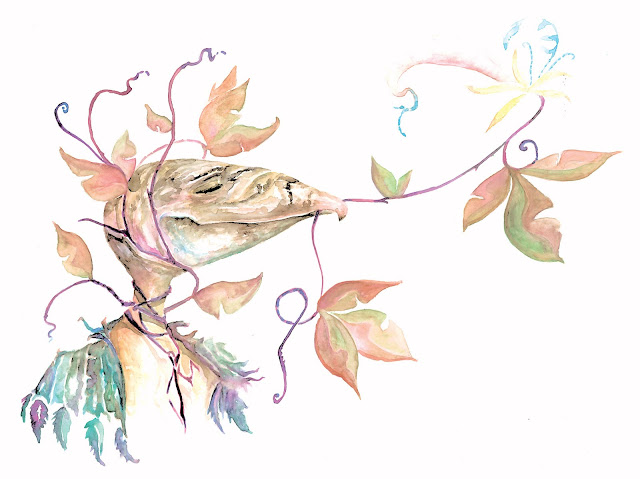
Organic body decoration is common among those of the Naku Islands.
Treatise of the Moons
Recently, I was gifted with a story of the Sun and the two moons in the Land of Mirico, whom it seems were given the wings of a generous creature, Feathabee, who wanted to help the bodies of the heavens to stay aloft in the sky. After the Sun and Moons found their own wings, it is believed that they cast down their borrowed feathers.
The former wings of the sun have not yet been recovered, but the greater moon, Alenda, left hers in the Bay of Maruksh. Here, two enormous vertical cliffs of stone, known as the Akkuliken, once stood in tandem until the encroaching waters of Lake Ku'ulukrae caused one of the great monoliths to topple sideways.
Now partially submerged, the fallen Akkuliken has been the subject of much debate among Miriconian historians, because of the thousands of intricate petroglyphs and carvings covering both massive stones.
When compared to the modern Miriconian language, the symbols of the Akkuliken loosely resemble many common symbols and letters. Concerned with the fact that much historical account would be lost when the submerged Akkuliken suffered water damage, a great effort has been taken to catalog the writings upon it.
An underwater rubbing, not easily acquired, was recently brought back and loosely translated, revealing a beautiful and haunting poem:
... and the Moons cast down their given wings
and learned to fly alone
and Here in pool of L'wambwah fell the massive wings of stone
... there writ upon each arch of rock
were characters and signs
the writings of the heavens told in mystical designs...
The former wings of the sun have not yet been recovered, but the greater moon, Alenda, left hers in the Bay of Maruksh. Here, two enormous vertical cliffs of stone, known as the Akkuliken, once stood in tandem until the encroaching waters of Lake Ku'ulukrae caused one of the great monoliths to topple sideways.
Now partially submerged, the fallen Akkuliken has been the subject of much debate among Miriconian historians, because of the thousands of intricate petroglyphs and carvings covering both massive stones.
When compared to the modern Miriconian language, the symbols of the Akkuliken loosely resemble many common symbols and letters. Concerned with the fact that much historical account would be lost when the submerged Akkuliken suffered water damage, a great effort has been taken to catalog the writings upon it.
An underwater rubbing, not easily acquired, was recently brought back and loosely translated, revealing a beautiful and haunting poem:
... and the Moons cast down their given wings
and learned to fly alone
and Here in pool of L'wambwah fell the massive wings of stone
... there writ upon each arch of rock
were characters and signs
the writings of the heavens told in mystical designs...
Iranian Bird Bowl, 4000 BC
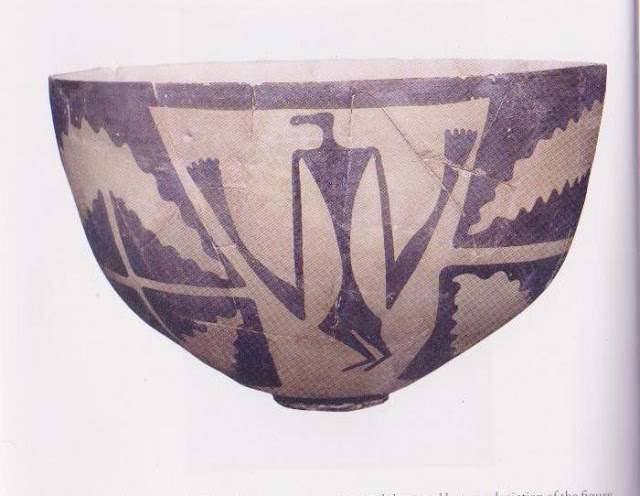
Courtesy of '10,000 Years of Art', Phaidon
A Potential Feathabee Find: Pottery from Southern Iran, 4000 BC
During the fifth Iridian century, figurative representations in the region of what is now southwestern Iran often showed human bodies with bird-like heads. A bowl found in Tall-i-Bakun shows in its motif a distinctly birdlike being, which to human historians and archeologists is tantalizing because of the fact that no later tradition sheds light on the character's identity.
A Feathabee sighting? Perhaps...
A Feathabee sighting? Perhaps...
Brothers Baschi and Beckle Feathabee Limited Edition 8x10 Archival Print

"Nice work, Brother Baschi!"
I'la Bird Doll Puppet

"Quite dashing, that scarf, eh?"
Gathering at the River's Edge

"Now there's a keeper."
the waterwalker

"Come this way, and I'll show you around."
with a basket of beans

'Annukha!'
the flutterbee

all dressed for the festival!
The Razzletree

This unusual tree grows fur to keep warm!

Feathabee creator Jorie Jenkins.
Subscribe to:
Post Comments (Atom)
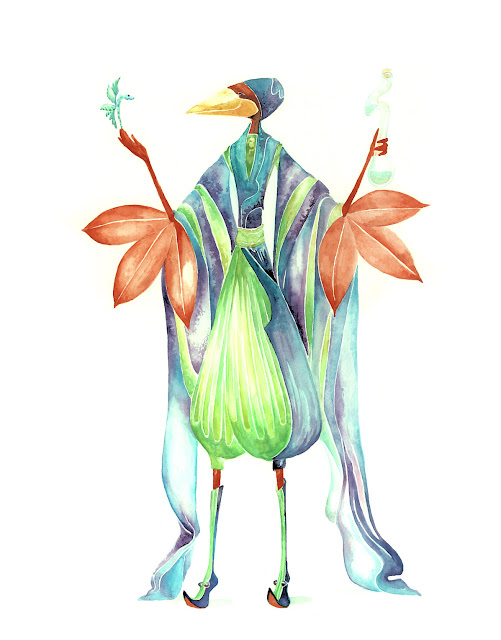
No comments:
Post a Comment